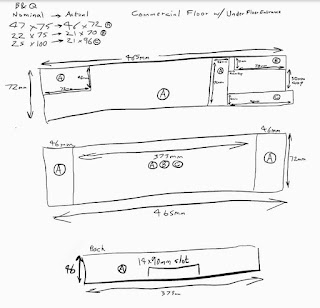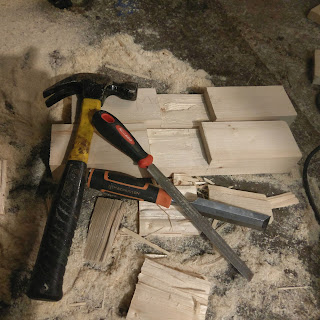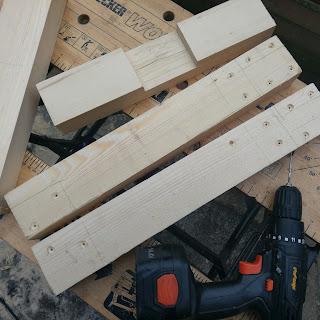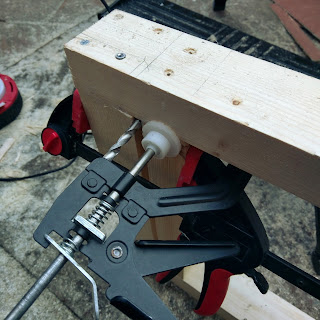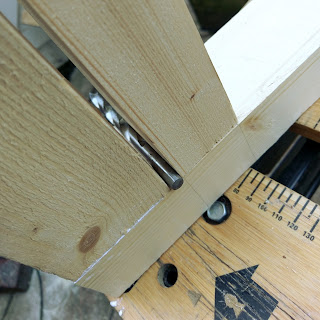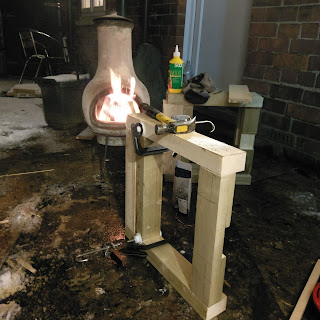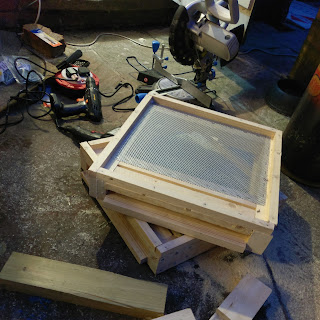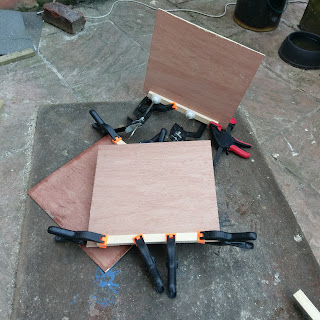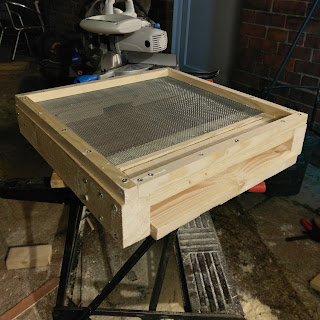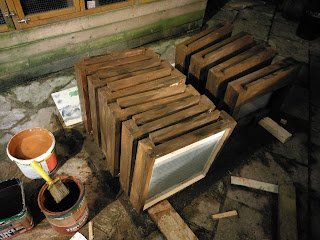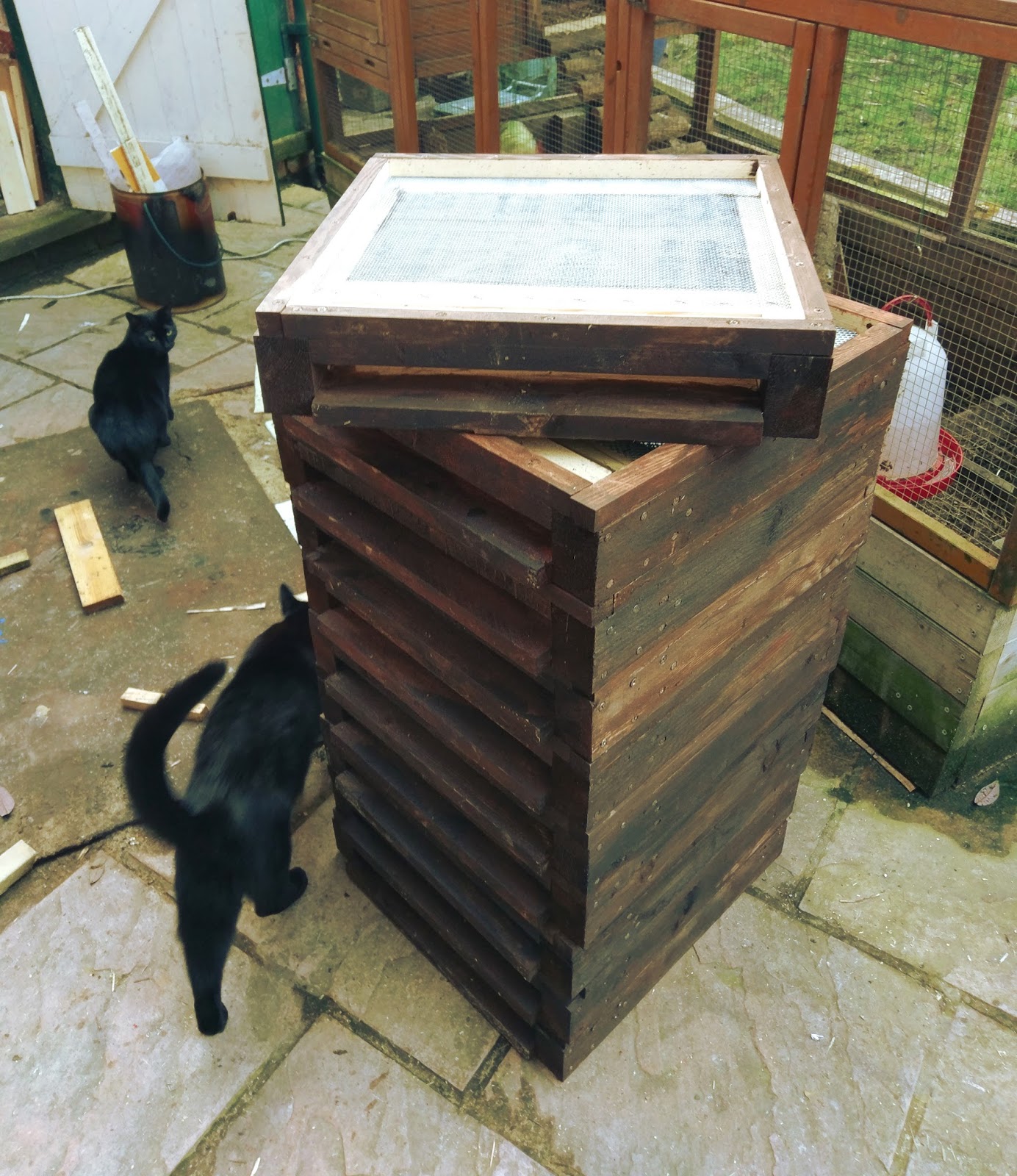Conflicting with Whitby Goth Weekend this year was
Beverley Beekeepers' Annual Auction. No doubt this caused sleepless nights for many beekeepers in the East Riding as they deliberated whether to dust off the
New Rocks and head for the coast or empty the back of the estate and head to Woodmansey in search of bees and woodware.
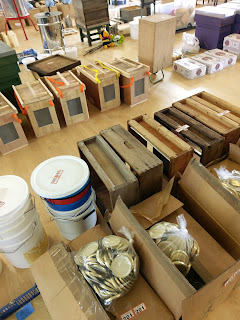 |
| Jars, buckets, woodware, shiny things, fondant.. |
The Auction started at 11am on the Sunday morning, I rocked up at half past. The hall was noticeably fuller than previous years. As expected alongside the usual hives and Supers there was a huge range of equipment on offer, ranging from buckets of formic acid pads and sugar to microscopes and a cuddly toy.
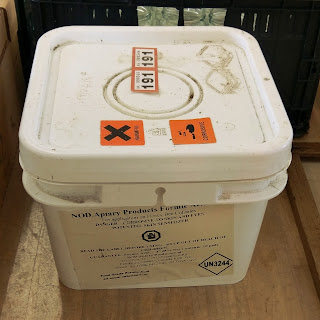 |
| Bucket of 10 Formic Acid Pads, went for a pound |
 |
| Hard to imagine an apiary without one of these |
Actually the bucket of Formic Acid went for £1, the cuddly Winnie the Pooh dressed as a bee and accompanied with a few large flowers went for £6. The acid is for treating Varroa, the Pooh bee and flowers are props for educating children about pollinators. I'm not sure what the
Brunel SP20 Microscope went for but there was also a binocular microscope amongst the lots too.
 |
| Beekeeping isn't all banging nails and burning stuff |
As usual there were a few shiny motorised extractors standing out against the boxes and wood. I bid on a couple of those but was unsuccessful so if I get a honey crop this year I'll be extracting with my trusty two frame manual extractor.
 |
| Motorised Extractor, it's gone to a new home. |
One thing that caught my eye was the
Honey Twin-Spin. A two frame electric extractor which appears to have been designed by some guy was hugely into fifties sci-fi and probably saw flying saucers in his sleep. It's a two frame radial extractor but unlike every other extractor I've ever seen holds the frames almost horizontal. It's made by
Brinsea Products who are still around but nowadays focus on poultry rearing.A quick Google finds the extractor mentioned in an old
Kent Beekeepers Association Newsletter.
The writer comments on how efficiently it extracted as well as being particularly
easy to clean too. It didn't generate much interest and there was only
myself and another chap bidding on it, he got it for £16. It's an odd looking and bulky thing but £16 for a motorised extractor is quite a
steal.
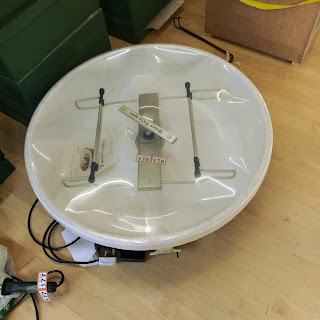 |
| Flash Gordon's Honey Extractor |
In previous years there's usually been a lot of Nucs on sale, probably because most beekeepers get free ones with their first colonies and later it's probably one of the first things they build for themselves. I've made four myself, and still have a couple of others knocking about. This year the Nuc contingent was limited to a group of five brightly coloured wooden Nucs and a couple of Poly Nucs with built in feeders. Perhaps people are keeping their spare Nucs for making splits later in the year.
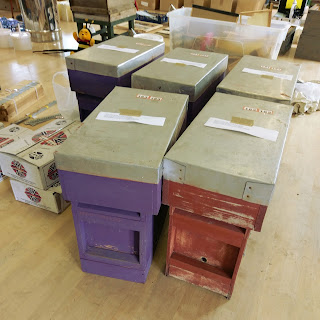 |
| How come that bear is in so many photos? :-o |
 |
| A couple of Poly Nucs |
Of course the main draw was the bees. Winter losses over 2017/2018 have been seriously high across the UK, Europe, USA and Canada, figures I've heard bandied about have been up to 90% for some. This means there's going to be a lot of beekeepers looking to replace stocks and conversely far less bees available for sale.
 |
| Bees for sale |
There were 12 colonies for sale this year. 8 of them were 5 frame Poly Nucs with July 2017 Queens ready to be hived.They went for £240-250 each. From the descriptions I think these nucs actually contained bigger colonies than my surviving hives at the moment. I've long since realised that trying to predict bidding is impossible so I wasn't hugely surprised when two full sized colonies in National Brood boxes complete with floor and roofs containing 6 and 7 frames of brood respectively went for £230 and £240 each. That's less than the smaller colonies in the Nucs and basically includes a usable hive. A Poly National hive with 6 frames of brood and four spare empty Supers also went for £240 and the last colony another Poly National but with a half filled Super and 3 spare empty Supers went for £250. The last colony I bought at a previous auction was £150 and one year in York I saw 2 Nucs going for £50 each, the prices this year probably reflected just how heavy the recent Winter losses have been.
 |
| These bees couldn't wait to get to work |
It was really cold outside but a lot of people braved it for the bee sales. Before proceedings went back inside a gazebo and a 6x4' trailer also went under the hammer. Whilst probably not the first thing most people think of a Gazebo would've been really useful for me over Winter when I was working on hive floors in the snow. I've also had the weather change after painting hive parts and hd rain completely wash off the wet paint in the past.
 |
| The right place for a gazebo or trailer |
Back in the warmth the hall was noticeably emptier. Probably as a lot of people had come specifically to buy bees -have I mentioned those Winter losses?.. I guess a few will also be going to the
York Beekeepers' Association Auction on May 12th. After the bees have sold and the crowd has thinned a little is a good time for bagging a few bargains. A few people got honey buckets with lids at four for a pound, mesh floors went for a pound each too. I picked up a solid wooden floor for £7, that'll be going under a spare hive at the apiary in case a passing swarm feels like moving in. They're also handy to have around when you're moving full Supers and extracting.
 |
| Perfect for Asda |
There's usually something unusual at these auctions and this time the oddest thing was probably a wooden box on wheels. Inside it on one side there were a couple of net curtain wires attached to the frame to hold things in place. The were also six swarm boxes on offer but they didn't meet their reserve.The swarm boxes are lightweight boxes the size of a 5 frame nuc with straps, a close fitting sliding lid and mesh areas for ventilation. When you're moving bees it's important to keep them cool. Being based in a city I've not had to travel far to collect a swarm yet so I just bring a Nuc when I go to collect them. If I was travelling further I'd probably think about one of these ventilated boxes.
 |
| Ratchet Straps, Uncapping Tray and Fondation |
As the Auction progressed I picked up a box of beekeeping books and a medium size bee suit for a fiver, quite a few people are interested in seeing my bees so I got that for visitors. There was some steelware in the form of a couple of uncapping trays, that always gets interest. A large honey warming cabinet went for £30, useful things, this one looked like it could take a couple of buckets at a time. At the moment I have some jars of liquid honey that's granulated so they'll need a spell in my warming cabinet before they sell.
 |
| Honey Warming Cabinet |
Something which didn't sell but would save someone a lot of labour was a motorised Honey Creamer. From the outside it looked a lot like an extractor but inside instead of a cage for frames there was a little propeller near the tank floor. You load it up with liquid honey, add some existing creamed honey from th previous year, turn it on then go do something else whilst it mixes. At the moment I use a strirring device that attaches to a drill and cream the honey in 9 litre buckets. It's still fairly hard work and takes a long time mix it consistently.
 |
| Honey Creamer |
 |
| Stainless Steel Settling Tank with Filters |
The second to last lot was a heavy little stack of glass rectangles. It turned out they were
glass quits,
basically a glass Crown Board. Each was in two halves and each half made from two panes of glass joined together. They allow a beekeeper to see where the bees
are in the hive without fully opening the colony. I'm not sure why these
are in halves but it might be to do with weight and strength, it'll also mean not
having to open up the full hive at once which should reduce flying bees. Nobody was interested in them although polycarbonate quilts had had some interest earlier in the day, so I
them up for £2, making them £1 each. I'll see how they are to use -if I like them I may be popping up the road to
Jack's Glass for some more. The last item was a very tall stainless steel Settling Tank with built in filters. I was interested in that but so was everybody else so it was soon bid out of my intended budget.
 |
| Section Racks |
Towards the end I managed to pick up a pair of Section Racks with metal spacers. There was the usual boxes of jars and foundation. I didn't need any
foundation this year having traded in a load of wax for foundation last year. I did pick up 72 1/2lb jars with lids for £12 and 72 1lb
jars with lids for 17. Not the most interesting purchases of the year but jars are quite an overhead for beekeepers so any
chance to save on them is welcome.
 |
| Solid hive floor and a little reading material |
When I got home with my little haul the first thing to do was scorch everything - well okay not the books, that'd've gone pretty badly, but the floor, section
racks, their metal spacers and even the smoker, whilst it doesn't come
into contact with bees it comes into contact with gloves that probably
have.
 |
| Snelgrove Board, front and back views |
I had bid on a couple of Snellgrove Boards but didn't win, however the chap from
Green Man Honey who had won them was kind enough to sell me one after the auction. They're made from two thicknesses of ply with cutaways at the exits on one side, an unusual way to do it but will certainly make for a strong board. When I scorched it the glue holding the mesh liquefied so I scraped it off, burnt it off the mesh then stapled the mesh back in place.
 |
| This Smoker reminds me of The Klangers. |
It was a fairly busy day, with three different auctioneers taking the gavel. The impact of the Winter losses on attendance was pretty obvious. As usual the auction is a handy place for beginners to quickly and cheaply stock up on kit. As well as the sales mentioned above National Hives assembled and painted, complete with two supers were going for £40-£50 each.





























